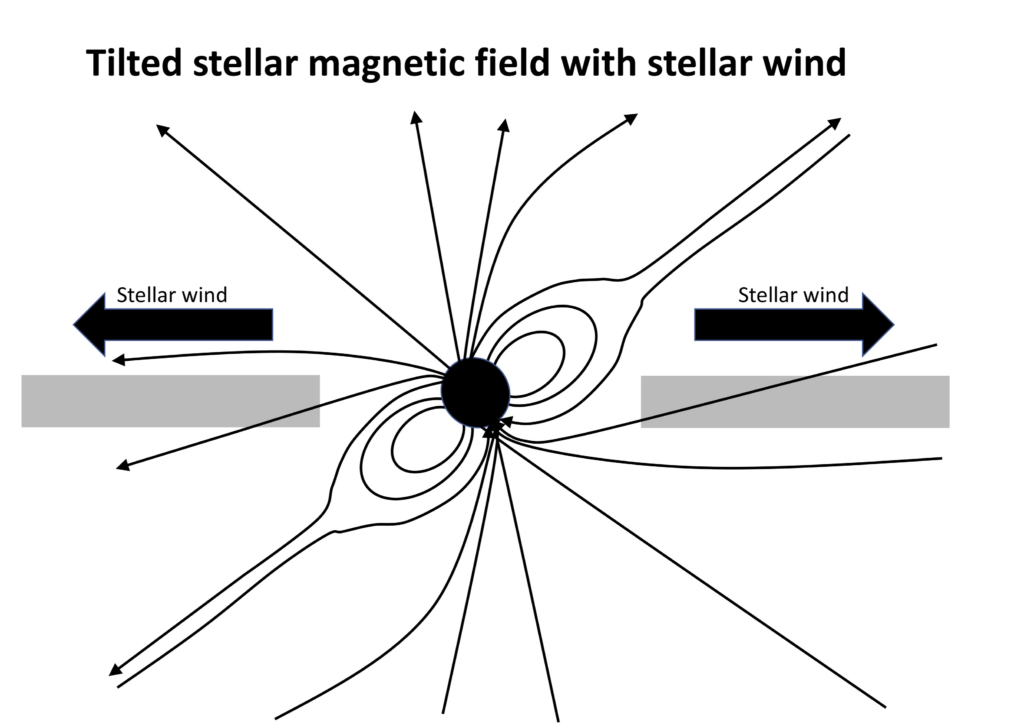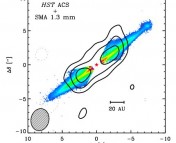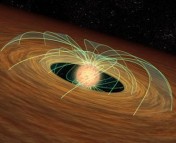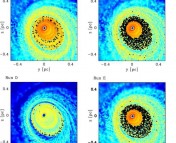Authors: Ofer Cohen, Cecilia Garraffo, Jeremy Drake, et al.
First Author’s Institution: University of Massachusetts Lowell
Status: Accepted for publication in The Astrophysical Journal
Stars are born in darkness, and in times of great upheaval. Supernova shockwaves, supermassive black hole jets, and collisions between galaxies can all cause pitch-black giant molecular clouds to fragment, and to collapse. Inside these fragments, a dense core forms: the embryonic star, surrounded by a dusty egg. Initially the growing star’s optical light emission is obscured by its dusty shroud. As the star grows, it blows away the dust and becomes visible, like it has hatched out of its dark shell. While it now shines like a star, it is not a mature one, for it has yet to ignite fusion in its core. We call these juvenile stars T-Tauri stars. Like how a newly hatched salmon still absorbs nutrients from its remaining yolk for a few days after hatching, the T-Tauri star consumes the remnants of its shroud to power its light. Long tubes of magnetic flux like umbilical cords channel ionized gas from the protoplanetary disk onto the star’s surface, helping it to shine until it can power itself on its own. Eventually fusion will ignite in its core, and it will clear away its protoplanetary disk, leaving only planets behind, the detritus of afterbirth.

At least this is the simplest picture. But birth is a messy process, even among stars. Today’s paper calls into question whether T-Tauri stars really are able to accrete as much as previously thought from their protoplanetary disks, and whether this is really the source of their famous flares.
Maybe if I Pretend the Spoon is a Spaceship You’ll Eat Your Plasma…
The authors of today’s paper are motivated by something that has been left out of T-Tauri star models: the corona and stellar wind. The corona is a thin, tenuous atmosphere millions of Kelvin hot that surrounds the star, and from which particles stream out at hundreds of kilometers per hour. We know from our own Sun that the corona is kept hot by its own heat source, and that the magnetic field lines running through it are open, not simply loops (see Figure 2). This creates a very different environment from the classical picture of a T-Tauri star as seen in Figure 1, which has a closed magnetic field and lacks a strong stellar wind. The star is not simply a passive consumer of its food: it deposits energy in its surroundings with its corona and winds. It is for this reason the authors decide to run the first simulation that includes a self-consistent stellar wind and corona, with the goal of understanding how they affect how the T-Tauri star accretes from its disk.

…Come on You Threw Your Carbon on the Floor Again?!
The authors simulate a star with solar mass and radius, and a rotation period of 90 days. The initial magnetic field of the star is 100 Gauss strong (about the strength of a bar magnet’s), dipolar, and tilted by 45 degrees relative to the star’s rotation axis. The protoplanetary disk’s inner edge is initialized at a distance from the star of 10 times the star’s radius. The initial magnetic field in the disk is zero. To induce inward flow of the disk onto the star, they reduce the velocity of its orbiting particles to be less than Keplerian. The authors note that these initial conditions for the protoplanetary disk are not realistic, but they are necessary due to the fact their simulation doesn’t have enough resolution to capture the real reason accretion happens. Once the simulation starts running, it settles down into a steady state that is realistic, so this isn’t as big of a problem as it sounds.
When the simulation starts, the disk spirals inwards and winds around the star, pushing the corona inwards and twisting the magnetic field lines. For the first 20 hours, there is significant inward motion of the disk and corona occurring, shown as the negative values on the top left panel of Figure 3, where the negative change in mass at the largest value of r means the disk is moving closer to the star. As this happens the corona is compressed and heats up (bottom left panel in Figure 3). This increases the ultraviolet and X-ray light that the star produces (bottom right panel in Figure 3). Angular momentum is transferred inward onto the star, and vastly exceeds the amount carried away by the star’s wind. However, all of this takes place during the system’s relaxation from the unrealistic initial conditions, and none of the infalling material from the disk actually makes it onto the star’s surface. It seems that feeding a baby star is like trying to feed an irritable toddler—the food ends up everywhere except the mouth.
Once the system starts to settle into a steady-state around 25 hours, the corona expands to a radius of around 15-20 times the star’s radius. At 50 hours and 78 hours into the simulation, the ultraviolet and X-ray emissions from the star dramatically flare, the characteristic temper tantrums that give T-Tauri stars their terrible-twos reputation. This can be seen as the spikes/bumps in flux in the lower right panel of Figure 5. However, looking back up at the upper left panel, there is no corresponding increase in the accretion rate. Contrary to popular models of T-Tauri stars, the flares seem to not be associated with increases in accretion rate at all.

By looking at how the disk-coronal boundary changes with time, the authors realized that the T-Tauri star’s flares are associated with compression of the corona. When the star’s corona is squished by the disk, the energy density present in its magnetic fields screams upwards, and the corona heats up, creating the flare. Eventually the corona pushes back against inward flow of the disk and re-expands, cooling and ending the flare. Repeated back-and-forth compression and expansion of the corona against the disk creates the repeating flares.
So if you see a crying T-Tauri star, don’t try to hug it. Or feed it. You’ll probably just end up making it mad.
Astrobite edited by Storm Colloms
Featured image credit: Lynnie Saade




